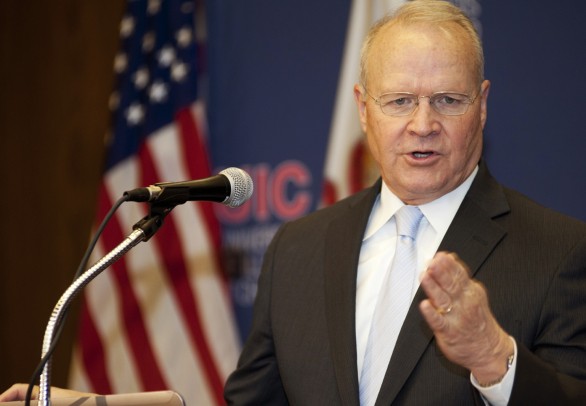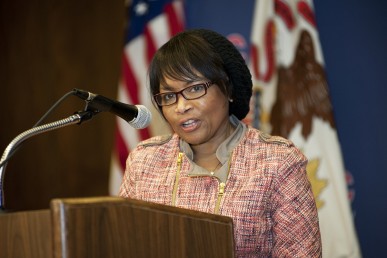Changing public perception of universities

“There is close, skeptical questioning about what we do and how well we do it,” Larry Faulkner says. Photo: Roberta Dupuis-Devlin/UIC Photo Services
The public views universities with skepticism, and experimentation is the way to change that attitude, Larry Faulkner says.
Faulkner, president emeritus of the University of Texas at Austin, laid out his analysis last week in his talk “Wise and Effective Academic Governance in an Age of Challenge.”
He spoke at Student Center West as part of the Chancellor’s Lecture Series, at the invitation of Chancellor Paula Allen-Meares.
Institutions of higher learning were “pretty broadly celebrated” through the first five years of this century, Faulkner said.
Today, however, “there is close, skeptical questioning about what we do and how well we do it,” he added.
“Are we efficient with the resources we have? Are we teaching students what they need to know? Why are so many students unsuccessful? Are we pursuing a research agenda that really matters?”
Faulkner said the “sea change” in public attitudes toward higher education has four roots:
• The exhaustion of the financial model for universities. Since the 1970s, public higher education has gradually traded out appropriated support for increased payments by students and parents, Faulkner said.
“The policy has worked well,” he said. “But we have come to the end of that road.”
Why? Because “superinflationary” growth in charges has made higher education too expensive for most families, Faulkner said.

Chancellor Paula Allen-Meares introduces former University of Texas president Larry Faulkner. Photo: Roberta Dupuis-Devlin/UIC Photo Services
Total debt from student loans now exceeds total credit-card debt, he said, and we must find a way to hold academic costs in check, with annual increases roughly matching those in mean household income.
• The advent of technology-based education. Web-based tutorials and instructional video have shown that “blended” instruction is a means to “saving a whole lot of money in higher education,” Faulkner said.
• A change in public views of the idea that all students should be college-ready upon graduation from high school. This shift is indicated by the tendency of public leaders to praise community colleges at the expense of four-year schools, he said.
• The continuing effect of the 2008 financial collapse. This has led to the questioning of efficiency and effectiveness for universities. There is “no easy way out” of the resulting budgetary stresses, Faulkner said.
“In laying out this fourfold basis for an age of challenge, I do not mean to depress you — although I do understand the risk,” he said.
The solution, he said, is to set attention on three issues: controlling costs, finding new methods for organizing enrollment and delivering instruction, and helping students make the transition from high school to college.
Experimentation is key, Faulkner said, with ideas to come mainly from faculty.
He offered four principles as a guide: establishing a clear understanding of the university’s mission and social purpose, operating with “fiduciary integrity,” committing to act consistently in the institutional best interest, and making decisions in a timely manner.
On that last point, Faulkner said, “Administrative officers who cannot act timely should be replaced.”
